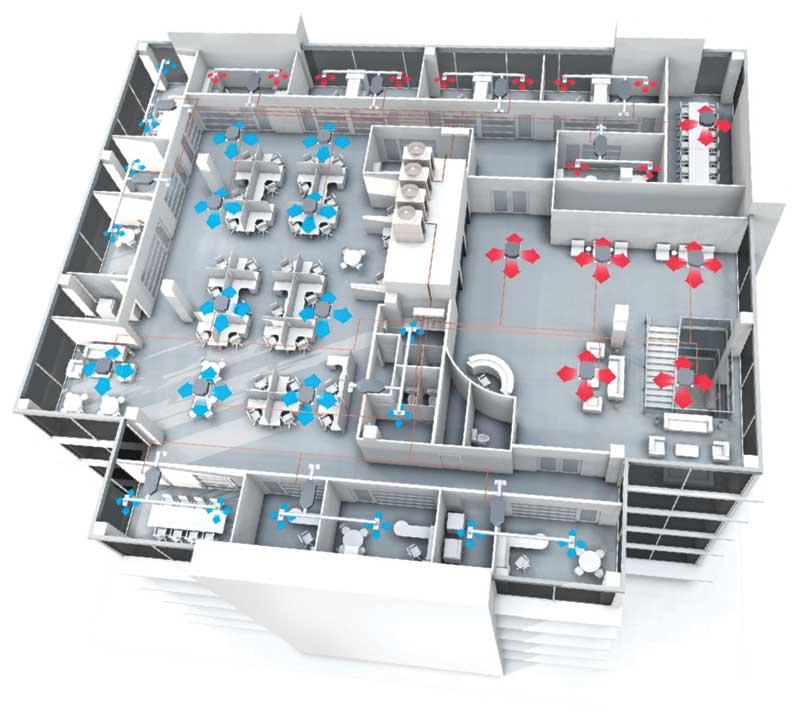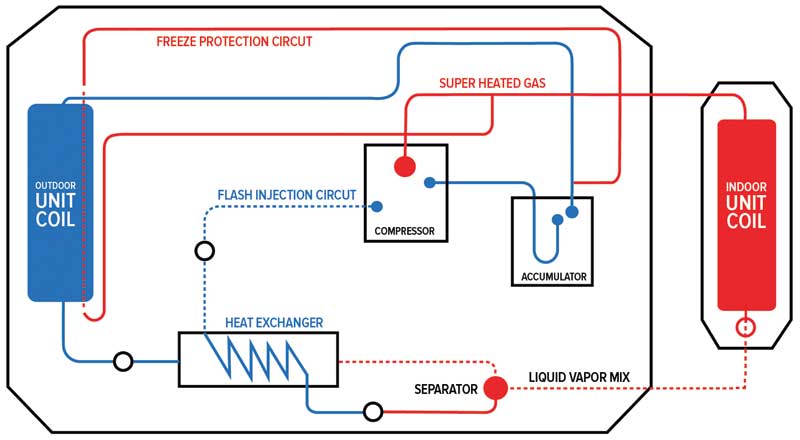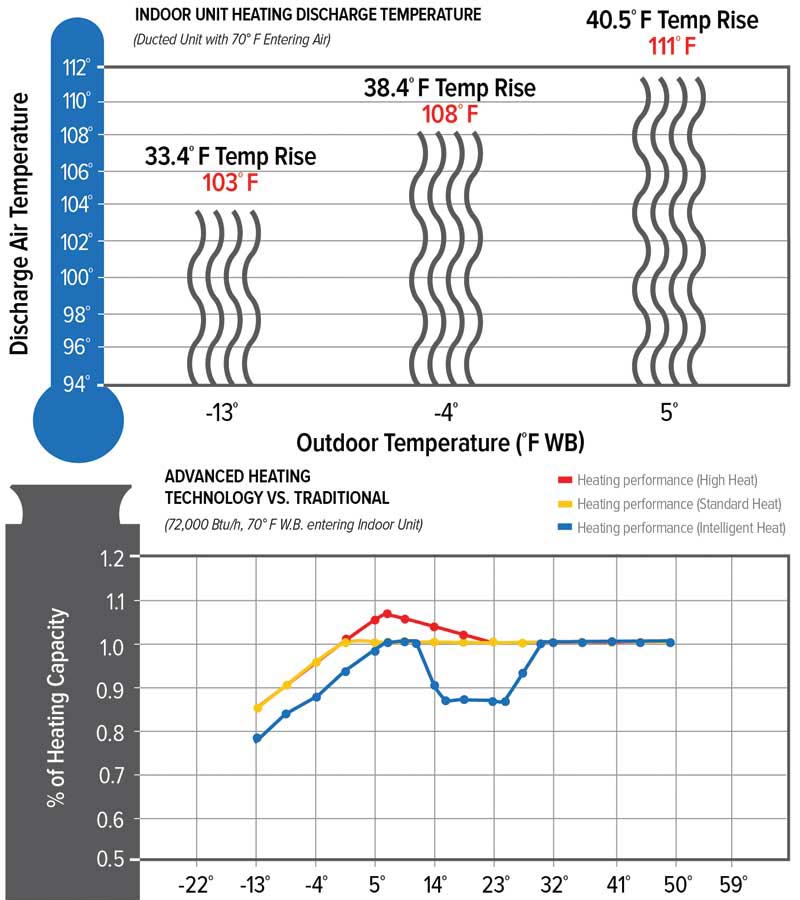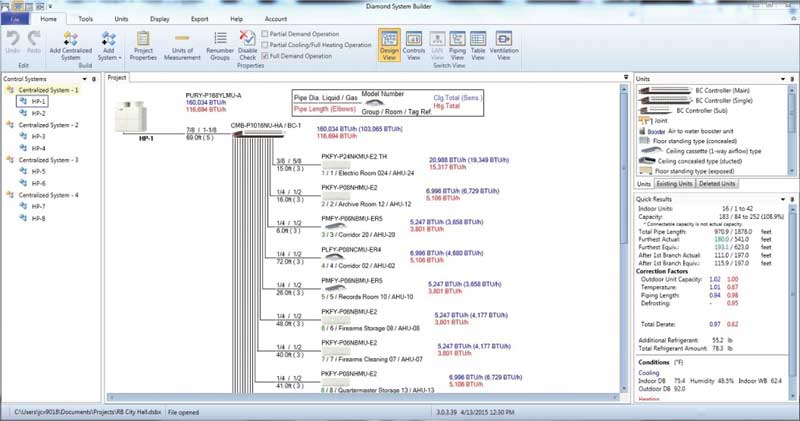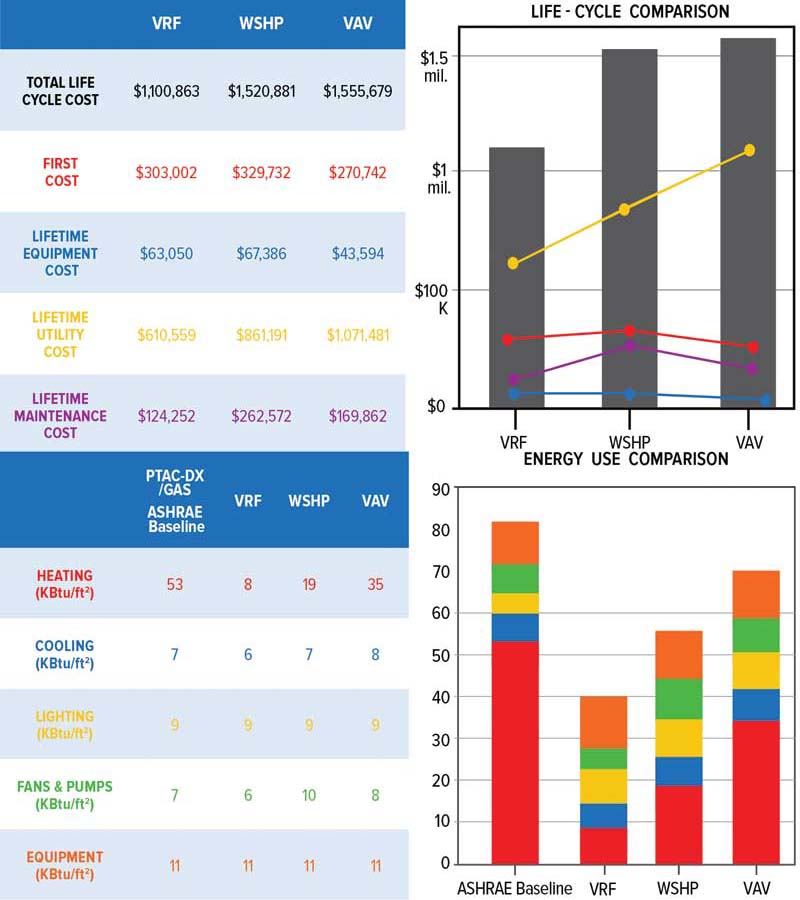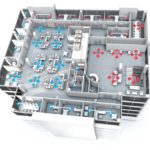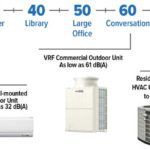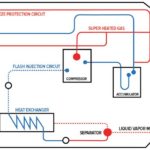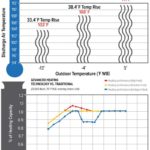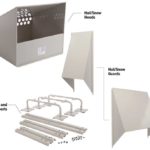Elimination of hot and cold spots, background noise
Just because a building is located in a cold climate does not mean every occupant requires the same temperature. Perhaps one side of an office building gets ample sunlight and actually needs cooling during the winter, or a health clinic or school has areas for both active and inactive occupants, thereby requiring a mix of temperatures. In these situations, VRF’s ability to treat hot and cold spots via zoning capabilities and simultaneous cooling and heating ensures everyone is comfortable (Figure 2).
At the same time, VRF literally operates at a whisper. Murmurs come in at 35 decibels, while indoor units have a lower decibel rating between 19 and 34 (Figure 3).
Advanced heating technology
There is currently no industry-wide definition of advanced heating technology since it is relatively new. Among the VRF manufacturers who offer it, a general definition of the technology is the ability to provide fully rated heating capacity at –17.8 C (0 F) or below, and offering substantial heating capacity at –25 C (–13 F).
How is this possible? First, it helps to know what has previously occurred. As the outdoor temperature drops below freezing, heat pumps have traditionally faced performance issues; the decrease in temperature causes a drop in the rate of the refrigerant flow circulating through the system, which in turn reduces the amount of heat generated. Advanced heating technology solves the problem via a flash injection circuit, or by inserting a portion of the refrigerant into the compressor at a lower temperature than normal, reducing the temperature inside the compression chamber. With the compressor running at higher speeds than normal, the system can maintain a high heating capacity despite colder outdoor temperatures. This process is typically used in units over 24,000 Btu/h of capacity, and kicks in automatically when the ambient temperature drops below –3.9 C (25 F).
Figure 4 shows a further breakdown :
- outdoor unit in heating mode sends superheated gas to indoor unit;
- gas becomes liquid/vapor mix inside indoor unit and migrates to the separator;
- heat exchanger pulls remaining heat from liquid/vapor mix—the mix becomes subcooled liquid;
- outdoor unit pulls heat from outside air to get liquid into gaseous form (the refrigerant must be colder than the air outside, making a freeze protection circuit necessary);
- flash injection circuit cools down the compressor; and
- a hot gas loop eliminates ice buildup in the freeze protection circuit.
The result of this technology is impressive capacity—for example, 100 percent at –17.8 C and 85 percent at –25 C.
In the case of VRF with heat recovery and advanced heating technology, simultaneous cooling and heating operation is generally available around –20 C (–4 F) instead of the –10 C (–14 F) associated with most manufacturers’ standard version of VRF. Having the ability to cool and heat simultaneously during negative ambient temperatures is necessary in applications such as office buildings that need to serve both workers sitting all day (requiring heating) and using gym facilities (requiring cooling) even as the temperature drops.
Between –20 C and –32 C, a VRF system with heat recovery and advanced heating technology will operate in heating mode only (Figure 5).
None of this, of course, would be possible without a defrost cycle. For a VRF system with advanced heating technology, modern defrost cycles:
- de-energize the reversing valve;
- stop the indoor unit fan motor, preventing cold air from being distributed into the conditioned space;
- stop the outdoor unit fan, allowing the outdoor coil to increase in temperature to more efficiently eliminate ice buildup; and
- operate the compressor at a higher speed, increasing the discharge gas’ temperature.
A VRF system with advanced heating technology looks at three variables to determine when a defrost cycle should be initiated: outdoor ambient air temperature, cumulative compressor operating time, and outdoor pipe temperature. The cycle auto-terminates either when the maximum defrost time is reached or when the outdoor pipe temperature has reached or exceeded a pre-set level for a pre-determined amount of time (e.g. 10 C [50 F] for two minutes). Defrost cycles occur more often when it is warmer out, for example 0 C (32 F) and snowing, than during periods of extreme cold given the lack of moisture in the air. Regardless of the temperature, building users likely will not notice the defrost cycle taking place at all. If their system stops heating, it will only be absent for a few minutes.
Some manufacturers offer a technology that creates heating capacity even during a defrost cycle. This happens by defrosting one section of the condenser coil at a time. The resultant operation shows a marked increase in heating capacity during defrost (from zero to 60 percent, depending on the outside temperature), as well as a small increase in overall heating capacity.
This technology takes different forms, depending on the manufacturer. Some use hot gas defrosts; others reverse-defrost or utilize a hybrid. With some manufacturers, a hybrid of hot gas and reverse-defrost can take place in a single module, making the technology applicable to smaller projects.
While hot gas defrost does increase the frequency of defrost cycles and make ‘cold blow’ possible, it is still widely sought after for its impressive increase to heating capacity.
Manufacturers who offer heat pumps with advanced heating technology also offer add-ons designed with cold-climate performance in mind. These accessories increase performance, and are necessary in extreme, snowy conditions. They include wind baffles, snow guards, snow hoods, snow stands, and base-pan heaters (Figure 6).
Features and benefits
VRF with advanced heating technology can earn impressive efficiency ratings. A typical system with advanced heating technology will perform with an IEER rating of up to 16.8; one with heat recovery and advanced heating technology will see even higher ratings—up to 18.4.
Advanced heating technology is also available in single-zone systems, also known as split-ductless or zoned comfort solutions. In these cases, the seasonal energy efficiency ratio (SEER) gets up to a rating of 30 with advanced heating technology, though most units are rated in the high teens or low to mid-20s.
VRF with advanced heating technology also has an impressive coefficient of performance (COP). At the Air-conditioning, Heating, and Refrigeration Institute’s (AHRI’s) standard test temperature of 8.3 C (47 F), VRF with advanced heating technology has a coefficient of performance (COP) of 3.8. At –17.8 C (0 F), it is still over two. At –25 C (–13 F), the COP is about 1.4. Even at –31.7 C (–25 F), the COP of 1.25 still wins out over standard electric heat’s COP of 1.0. In short, advanced heating technology enables performance, which is more efficient than other options in extreme cold temperatures.
Cost savings
The initial cost of VRF technology can be higher than traditional systems. In cold climates, the first cost can increase further due to factors like a higher electrical requirement or the need for cold-weather accessories. However, VRF’s installation cost is often lower than systems providing similar comfort and control; for example, a four-pipe boiler/chiller setup with a building management system (BMS). This is because with VRF, a controls system comes standard and users can add advanced monitoring and control for a fraction of the cost of a BMS.
Operation represents another venue of cost savings with VRF. As efficiencies increase, operational costs decrease. Thanks to the system’s inverter-driven compressor, users can expect to see a savings of up to 25 percent on utility bills. The result is the cost over a system’s lifetime represents ample saving, along with other benefits like comfort and sustainability.
Ease of design and specification
VRF manufacturers offer professionals an arsenal of tools to make design and specification easy and successful. The example in Figure 7 shows the interface of a manufacturer-provided tool helping users determine the cooling and heating output of selected equipment for project-specific locations. The program has error indicators and built-in safeguards against exceeding limitations; this ensures line lengths, maximum connected capacities, component selections, and control schemes are within manufacturer guidelines. Since VRF with advanced heating technology can serve as a building’s sole heating source throughout the year, this is the simplicity of having just one cooling and heating system. Reducing the number of required systems has profound effects, which saves building users upfront and installation costs, freeing up space where additional systems previously would have been required and reducing maintenance needs and complexities.
Along those lines, the building owner benefits from having properly sized equipment, which ultimately results in a longer operational life. Traditional equipment is often oversized to meet the heating needs during periods of extreme cold. This is problematic because oversizing degrades equipment by running the compressors at full speed for long periods, which results in a hot exterior temperature. VRF with advanced heating technology protects the compressors through an enhanced refrigerant circuit to avoid this degradation. The importance of this benefit cannot be overstated; protecting the unit in extreme cold climates is a huge step forward, and will help ensure the equipment’s long life and continuous operation.
Advanced control benefits
VRF with advanced heating technology offers a variety of control options bolstering operational savings and personalized comfort. On a smaller scale, several types of controllers are available to provide personalized temperature control. On a larger scale, centralized controllers can monitor, schedule, and control multiple indoor units through a web browser interface. Multiple central controllers can be networked together with integrated centralized control software and systems can even be tied to a building management system. With controls built into the equipment and easily expanded on, this means more effective operation and further cost savings.
Even for geographical locations where gas is incredibly inexpensive, VRF with advanced heating technology is a worthwhile option because of VRF’s personalized comfort control through zones, flexible design and installation, and the ability to right-size equipment (which results in more operational life out of a system). Further, as more projects incorporate solar panels and alternate energy generation methods, using an HVAC system fueled by electricity becomes a way to reduce the project’s carbon footprint. For example, opting for a single cooling and heating system also means eliminating the need to purchase a central air-conditioning system in addition to a boiler.
Over a product’s life cycle, these benefits add up—ultimately making the case that VRF with advanced heating technology can be a superior choice to other options. Some manufacturers have developed efficiency evaluation tools demonstrating the advantages and simulating the life cycle cost and other calculations for old and new buildings. In Figure 8, output from two actual simulations is demonstrated. The first compares the life cycle cost of VRF with advanced heating technology to water source heat pump (WSHP) and variable air volume (VAV) systems. The second compares the energy use intensity (EUI) of VRF with advanced heating technology to WSHP, VAV, and packaged terminal air-conditioners.
Conclusion
For decades, variable refrigerant flow has enabled building professionals to push the envelope in many parts of the country. With advanced heating technology, VRF is now a solution, not a challenge, in extreme cold climates, making it an enticing option no matter the geographical location. Users across a variety of applications are already enjoying the benefits of VRF throughout the year, including zoning control and great efficiencies. From here, efficiencies will only improve.
Cain White is the senior commercial product manager at Mitsubishi Electric US Inc.’s Cooling & Heating Division. He oversees the ongoing development of HVAC products and solutions for the commercial market segment. This includes the overarching development and execution of commercial product development strategies, product introduction, and life cycle management plans. White previously served as technical service manager in Mitsubishi Electric’s Southwest Business Unit. He can be reached through marketingdepartment@hvac.mea.com.



